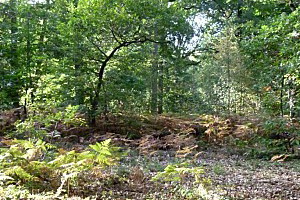 The sylvothérapie is a mode of care which is to install some convalescent or sick (victims of lung disease in General) in forests to provide cleaner air.
The sylvothérapie is a mode of care which is to install some convalescent or sick (victims of lung disease in General) in forests to provide cleaner air.
Sylvatiques cures have long been developed in some countries, particularly in the 19th and early 20th century for TB patients in temperate and northern forests. A sanatorium (and their solarium) and various types of spa treatment centres were installed in or on the edge of Lake forest environments. Some still function.
Principles
The patient may benefit, in certain seasons and some forest sites:
- a peace and a generally peaceful environment. For illustration, a study showed that the blood of people who have walked in the Woods contains a cortisol levels much lower that that of people having covered the same distance in the city. However this hormone is regarded as one of the main stress hormone. The green tone of the environment seems to favor healing; Roger Ulrich, who studies human behaviour at the University A & M of Texas note that patients recover more quickly when their room gives on a space Green; They are less in need of painkillers and suffer less nausea. The presence of large green plants also seems to have a déstressant effect, and some have been laboratory very effective to adsorb or break down many urban pollutants and indoor air (see program Phyt’air, for example)
- of cleaner air. Indeed, dew, mosses and lichens set quickly and effectively suspended particles and aerosols in the air. Fungal spores may be many in wetlands rich in decaying matter and many parties. Some can be allergens.
- After the advent of the Manege, particularly inspired by Pasteur, various measures cited by g. pleasure have compared different air and shown that forest air contained far fewer germs than urban air (50 microbes by m³ of air in the littoral forest, against 1,000 in the parc Montsouris in paris), 88 000 on the Champs-Élysées, 575 000 on the grands boulevards, and 4 000 000 in stores in Paris by Georges pleasure
- a microclimate with warmer temperatures (effect-the forest buffer) curves
- air enriched native dioxygen (three times more than dioxygen produced by the temperate in prairie). (In the summer or in the winter when the Sun is shining and there is little wind, a low share of dioxygen in the forest air can be converted by solar ultraviolet ozone, including in coniferous forests). This phenomenon is still amplified on the seafront; Samples at the International University of the sea, show analysis than a germ per m3 of air on the high seas, against 50,000 in the centre of a city like Paris, solar UV, native oxygen and the antibiotic substances naturally released by the sea. Ozone is an aggressive gas to eyes and lung mucosa too high dose, but it also has disinfectant properties that may play a role in sylvothérapie.
Air naturally enriched with essential oils (ex: terpenes) and phytoncides (antibiotic molecules naturally secreted by trees to defend against their pathogens). The East cedar, pine in Europe or North America balsam fir have been long known to be good for the health of those who breathe the smell.
It has recently shown that the biochemical activity is much richer and more intense in the canopy in the herb layer, particularly in tropical forest, but it has not sought to measure whether patients would benefit from breathing air at canopy height.
Attention, the forest houses also pathogens and vector species (it is the case of ticks) of several diseases which can be dramatic for people whose immune system is weakened. These patients must protect themselves and avoid going to areas of risk.

























